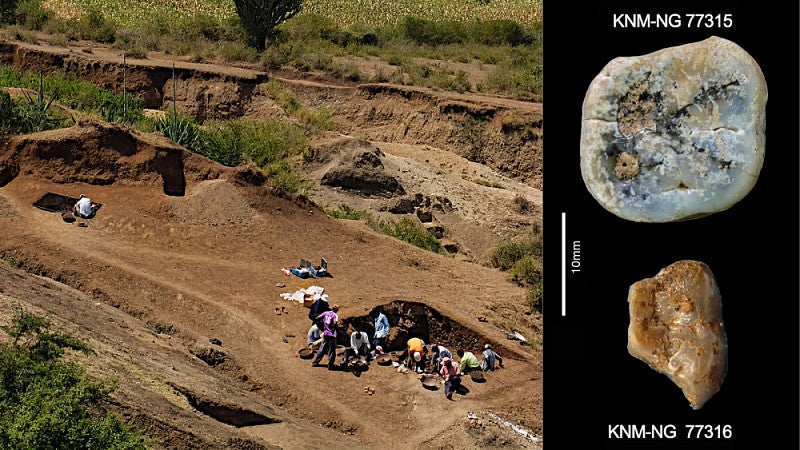Early human ancestors used small hand-held stone tools to butcher animals and crush plants.
At an archaeological site in present-day Kenya, researchers have unearthed some of the oldest examples of such so-called Oldowan tools, dating to 2.6 million to 3 million years ago.
The site, along the shores of Lake Victoria, is more than 800 miles away from previously found examples of the earliest Oldowan tools, expanding the geographic range in which this important prehistoric technological advance is known to have originated.
In the same area, researchers found bones of ancient hippos, scored with cut marks from stone tools - the oldest-known clear evidence of large-animal butchering. Among the remains of various extinct animals, researchers also unearthed the oldest known fossils of Paranthropus, an ancient, small-brained human relative who is part of a side branch of the human evolutionary tree.
"It's an incredible package of fossils and artifacts all preserved together," said Scott Blumenthal, a UO anthropologist.
In partnership with the National Museums of Kenya, scientists from around the world have been collecting bones and artifacts from the site, called Nyayanga, for years, gradually piecing together a story about its inhabitants.
They describe their findings in a paper published Feb. 9 in the journal Science. Blumenthal and UO colleague Stephen Frost contributed to the paper, providing important context that helped build an interpretation of the archaeological evidence. Both Blumenthal and Frost are part of the UO's Department of Anthropology, in the College of Arts and Sciences.
"We found these tools from a very early age, earlier than what we would have expected, and quite far away from where the earliest Oldowan tools were found before," Blumenthal said.
Frost calculated the ages of ancient monkey fossils found among the other bones and artifacts, helping to estimate the age of the site overall and understand what the environment may have looked like at the time.
"The monkeys indicate that even though the predominant picture is of a relatively open, grassy landscape, water and significant tree cover were available at least in local patches, illustrating the complexity of past environments and the range of resources available," Frost said.
And Blumenthal, who co-directs the UO's Stable Isotope Lab, analyzed the teeth of Paranthropus and other mammals found at the site to piece together dietary details. Different kinds of plants contain different forms of carbon, known as isotopes.
By looking at the ratios of different carbon isotopes preserved in tooth enamel, researchers can get clues to what the ancient primates were eating. The individuals appeared to be eating a diet heavy in grasses and sedges, or animals who grazed on those plants, Blumenthal concluded.
The stone tools found at the site back that up: The microscopic wear patterns on their edges suggest they were used to pound both plants and meat. And those tool-users were pursuing some large prey. Some of the hippo bones at the site had butchery cut marks on them, suggesting that someone had removed the meat from the bone using a tool.
"It shows they were engaging with these very big animals on the landscape, as more of a predator themselves," much earlier than scientists previously believed, Blumenthal said. That's a high-risk but high-reward strategy. "It's dangerous, but if you can get to it, it gives a huge amount of nutrients."
The evidence at the site also raises an intriguing but controversial possibility: that Paranthropus, rather than a closer human ancestor, could have been making and using those early tools. It's long been believed that Oldowan tool-making was restricted to the direct ancestors of humans. The more distantly related Paranthropus, with their giant molars, was presumed to not have as much need for tools.
The finds suggest that toolmaking represents an ancient innovation practiced more widely among evolutionary relatives of humans than previously believed, raising questions about what really differentiates humans, the researchers said.
But future work at the site could reveal the fossilized remains of more direct human ancestors known to be tool-users. So who exactly was inventing and using the stone implements remains an open question.







